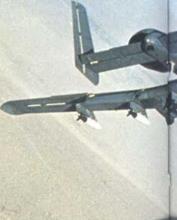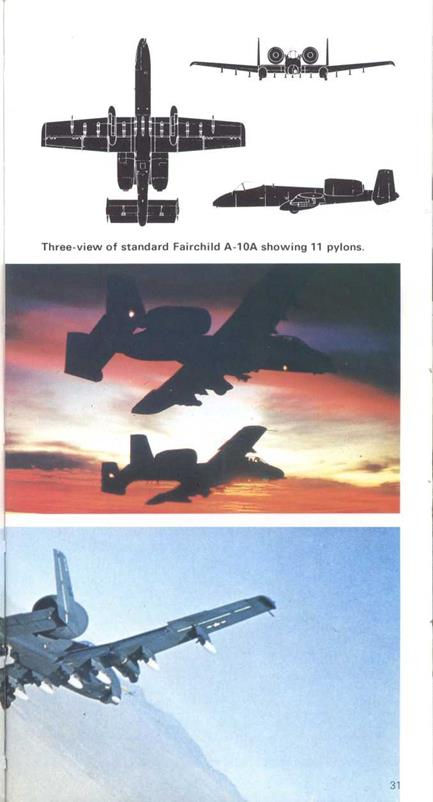Fairchild Republic A-10A Thunderbolt II
A-10A
Origin: Fairchild Republic Co, USA,
Type: Single-seat close-air-support aircraft.
Engines: Two 9,275lb (4207kg) thrust General Electric TF34-100 two – shaft turbofans.
Dimensions: Span 57ft 6in (17-53m); length 53ft 4in (16-26m): height 14ft 5iin (4-4m).
Weights: Empty 21,8131b (9894kg): maximum loaded 47,2001b (21,410 kg).
Performance: Maximum speed (clean) 460mph (740km/h), 380mph (612km/h) at maximum weight: initial climb 1,000ft (328m)/min at maximum weight: take-off distance (at maximum weight) 3,850ft (11 73m),
(at forward-airstrip weight with six Mk 82 bombs), 1,1 30ft (344m): steady speed in 45° dive with full airbrake 299mph (481 km/h): close-air-support radius with reserves 288 miles (463km): ferry range 2,723 miles (4382km). Armament: 30mm high-velocity GAU-8/A cannon in forward fuselage:
11 pylons for total external ordnance load of 16,0001b (7257kg) (exceptionally, 18,5001b, 8392kg).
History: First flight 10 May 1972: service delivery for inventory December 1974.
User: US Air Force.
Development: Despite the more overt attractions of Mach 2 aircraft the US Air Force was forced to consider the CAS (close air support) mission because of the total unsuitability of its existing equipment. In both the wars it had had to fight since World War II – Korea and Vietnam – its aircraft had been worldbeaters but planned for a totally different kind of war. What was needed, it appeared, was something like an up-to-date Skyraider that could carry a heavy load of ordnance, had good endurance and could survive severe damage from ground fire. Between 1963-69 extensive ►
Right and below: Thunderbolt lls pictured during their initial shakedown flying at Davis-Monthan and IMellis AFBs.
|
|
|
|
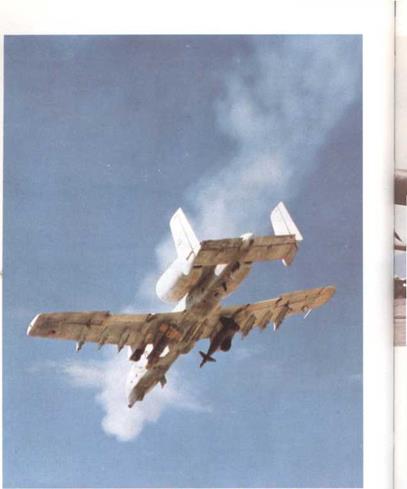 |
studies gradually refined the AX specification, which had begun by presupposing a twin turbo prop and ended with a larger aircraft powered by two turbofans. After an industrywide competition the Northrop A-9A and Fairchild A-10A were chosen for prototype fly-off evaluation, which took place with two of each type at Edwards in October-December 1972. The A-10A was announced winner and GE the winner of the contest to produce the 30mm tank-busting gun, the most powerful ever fitted to any aircraft, with very high muzzle velocity and rate of fire, and muzzle horsepower 20 times that of the 75mm gun fitted to some B-25s in World War II. Named Avenger, this gun is driven hydraulically at either 2,100 or 4,200rds/ min, and is fed by a drum containing 1,350 milk-bottle-size rounds. Empty cases are fed back into the rear of the drum. By 1978 ground-reloading will probably be done by a*special powered system. Underwing load can be made up of any stores in the Tactical Air Command inventory, the landing gears (which protrude when retracted for damage-free emergency landing) and all tail surfaces are interchangeable, the cockpit is encased in a "bath" of thick titanium armour, and the engines are hung above the rear fuselage where their infra-red signature is a minimum. Originally Tactical Air Command intended to buy 600 of these grey-painted brutes, but despite unavoidable escalation in cost and degradation in performance the planned number has grown to 733, of which half had been delivered by 1980 at a current rate of 1 4 per month.
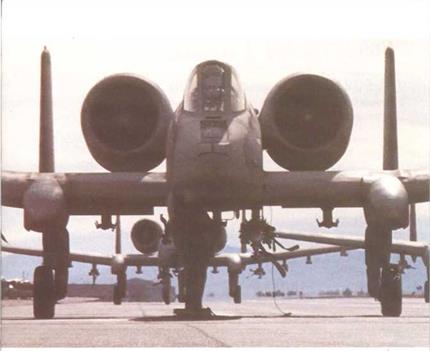 |
Above: Thunderbolt Ms on the flight line at Nellis where the USAF Tactical Fighter Weapons Center is located. Operationally the A-10A is classed as a fighter, though this is not its role.
Left: Firing the 30mm GAU-8/A cannon at simulated armour; this is the most powerful gun ever fitted to an aircraft. The pilot has not opened his split ailerons which in dives serve as brakes.
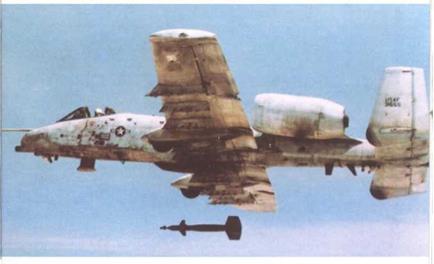 |
Below: Releasing a Paveway-series Mk 82 laser-guided bomb from level flight. Targets are detected by the Pave passive laser receiver pod seen carried on a pylon under the nose.











